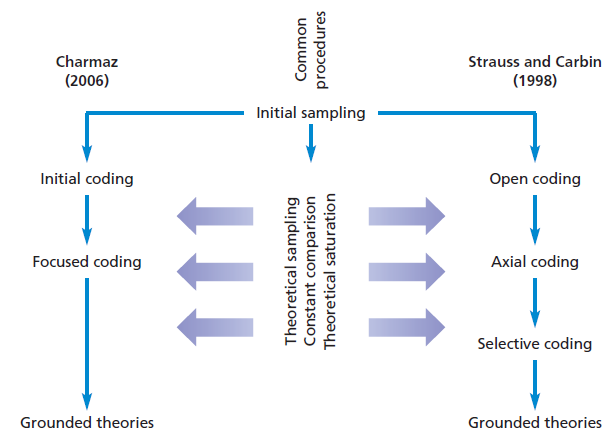Theoretical sampling
Theoretical sampling can be defined as “the process of data collection for generating theory whereby the analyst jointly collects, codes and analyses his data and decides what data to collect next and where to find them in order to develop his theory as it emerges”[1]. In simple terms, theoretical sampling can be defined as the process of collecting, coding and analyzing data in a simultaneous manner in order to generate a theory. This sampling method is closely associated with grounded theory methodology.
It is important to make a clear distinction between theoretical sampling and purposive sampling. Although it is a variation of the purposive sampling, unlike a standard purposive sampling, theoretical sampling attempts to discover categories and their elements in order to detect and explain interrelationships between them.
Theoretical sampling is associated with grounded theory approach based on analytic induction. Theoretical sampling is different from many other sampling methods in a way that rather than being representative of population or testing hypotheses, theoretical sampling is aimed at generating and developing theoretical data.
Theoretical sampling may not be necessary for bachelor level or even master’s level dissertations since it is the most complicated and time consuming sampling method. However, theoretical sampling is well suited to be applied for PhD-level studies.
Application of Theoretical Sampling: an Example
Theoretical sampling cannot be planned in a detailed manner before primary data collection process. As it is illustrated in figure below, theoretical sampling is systematically applied throughout the research process up to the generation of the grounded theory.
Theoretical sampling and generation of grounded theory[2]
Let’s illustrate the application of this sampling method by using a basic example. Imagine your dissertation topic is the following:
The impact of the Brexit on emotional wellbeing of consumers in Birmingham
The application of semi-structured interviews and theoretical sampling to complete this study will involve the following four steps:
Step 1: Make initial decisions are made regarding specific individuals or groups of people who have knowledge about the research area.
Semi-structured interviews need to be conducted with about heads of 15 households in order to assess the impact of the Brexit on them on emotional level.
Step 2: Analyse the initial data until theoretical ideas start to emerge and particular concepts arise.
Analysis of interview results may reveal that interviewees enjoy a sense of independence as a result of Brexit, however, they are concerned about their future at the same time.
Step 3: Choose further participants, events or situations on the basis of theoretical ideas and concepts revealed in the previous stage.
In our case more participants need to be selected in order to indentify the exact nature of Brexit-related concerns via conducting semi-structured interviews.
Step 4: Continue with steps 2 and 3 above until theoretical saturation is reached. Theoretical saturation “signals the point in grounded theory at which theorizing the events under investigation is considered to have come to a sufficiently comprehensive end”.[3]
Results of additional numerous interviews may reveal that weakening pound, the UK’s currency and the loss of special privileges in trading with EU-member states are the main source of concern for the sample group members with direct implications on their emotional wellbeing. This finding may re-occur time and time again with additional interviews indicating that theoretical saturation has been reached.
It is important to stress that unlike other sampling methods, theoretical sampling cannot be pre-planned and from the outset, but occurs at a later stage of the research process.
Advantages of Theoretical Sampling
- The possibility to strengthen the rigor of the study if the study attempts to generate a theory in the research area.
- The application of theoretical sampling method can provide a certain structure to data collection and data analysis processes, thus addressing one of the main disadvantages of qualitative methods that relate to lack of structure.
- This type of sampling usually integrates both, inductive and deductive characteristics, thus increasing comprehensiveness of studies.
Disadvantages of Theoretical Sampling
- Because it is a highly systematic process, application of theoretical sampling method may require more resources such as time and money compared to many other sampling methods.
- There are no clear processes or guidance related to the application of theoretical sampling in practice
- Overall, theoretical sampling is the most complicated than other sampling methods
My e-book, The Ultimate Guide to Writing a Dissertation in Business Studies: a step by step approach contains a detailed, yet simple explanation of sampling methods. The e-book explains all stages of the research process starting from the selection of the research area to writing personal reflection. Important elements of dissertations such as research philosophy, research approach, research design, methods of data collection and data analysis are explained in this e-book in simple words.
John Dudovskiy
[1] Glaser, B.G. & Strauss, A.L. (2012) “The Discovery of Grounded Theory: Strategies for Qualitative Research” Aldine Transaction
[2] Saunders, M., Lewis, P. & Thornhill, A. (2012) “Research Methods for Business Students” 6th edition, Pearson Education Limited
[3] Given, L.M. (20080) “The SAGE Encyclopedia of Qualitative Research Methods” SAGE


